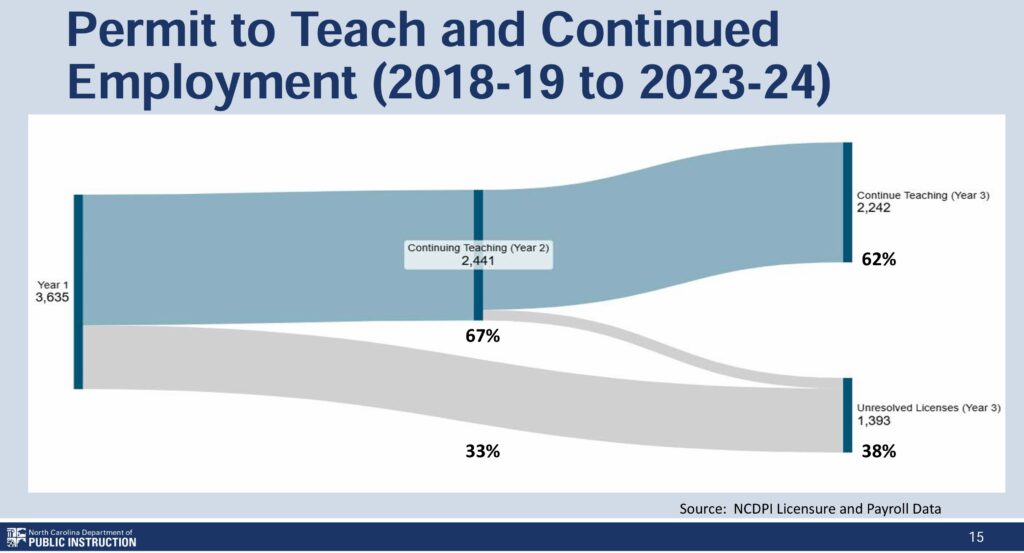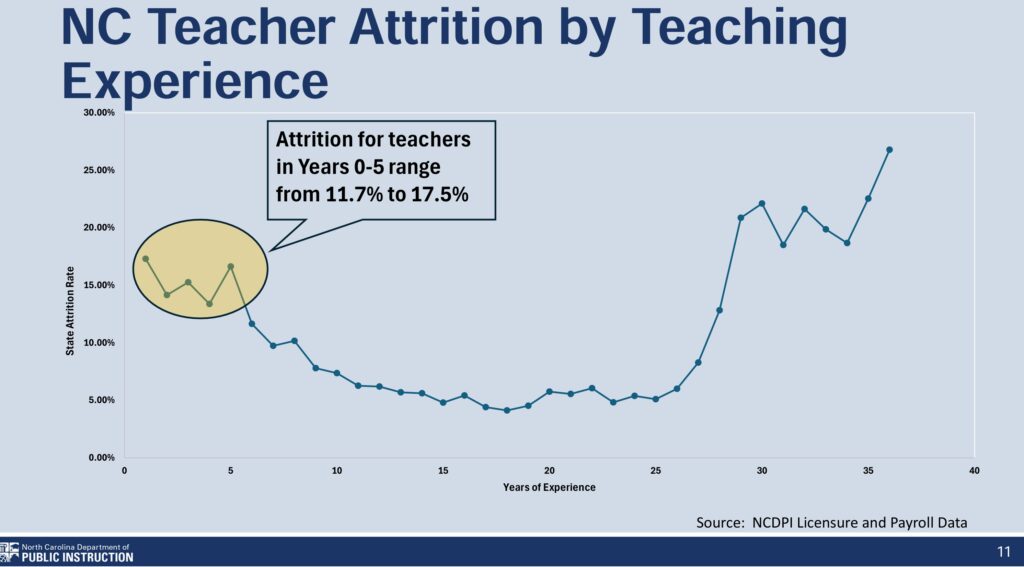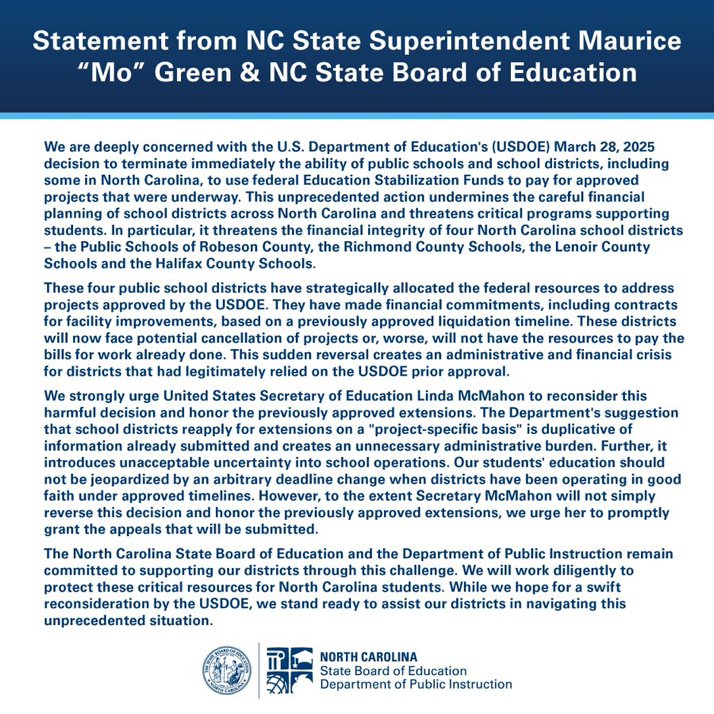The State Board of Education reviewed the latest numbers on teacher attrition and vacancies at their April meeting this week.
The annual State of the Teaching Profession report found a slight decline in teacher attrition, otherwise known as turnover, during the 2023-24 school year. However, the attrition rate is still higher than the average for over the past seven years.
“While the report shows improvement in the percentage of teachers staying compared to prior years, there are still far too many teachers leaving the profession,” state Superintendent Maurice “Mo” Green, said. “We need to do a much better job of keeping them in the classroom once they are hired. That starts with revering these professionals for the amazing job they do and providing them with great salaries and opportunities for growth within our public schools.”
The N.C. Department of Public Instruction (DPI) has released a data dashboard, which includes attrition data from every district between March 2023 and March 2024, and goes as far back as the 2020-21 school year. The dashboard includes data on resignations of both teachers and principals, the number of educators moving between districts, and vacant positions.
The first tab in the dashboard includes district, regional, and statewide data on attrition, mobility, and recoupment. Note the drop-down menu for the year, region, LEA, and low-performing designation.
The second tab includes district and statewide data on teacher vacancies, including the first day of school, day 40, by subject, grade level, and other hard-to-staff variables, like Exceptional Children department teachers.
The third tab includes the reasons for teacher attrition.
The fourth tab is teacher attrition by years of experience.
The fifth tab is EVAAS index scores by attrition and years of experience.
The sixth tab, newly added this year, includes data for principal attrition and movement between schools and positions.
Data in the report is also sorted for each local education agency (LEA), or school district. Attrition by LEA is reflected as the percentage of people who left the district between March 2023 and March 2024. Teachers are counted in this percentage whether they got a job in a different district or left North Carolina public schools all together.
The LEAs with the highest and the lowest attrition rates were Tyrrell and Clay County Schools, at 35.71% and 7.69% respectively.
Board Chair Eric Davis pointed out that the report doesn’t necessarily paint a complete picture of the teaching profession because it leaves out charter and other school choice options.
“The name of this report, State of the Teaching Profession, implies state of teaching profession across the state, but we’re leaving out 10% of those that are in the profession,” he said. “… We care about the performance of those teachers and students.”
Attrition
The attrition rate for the 2023-24 school year stood at 9.88%. This is a slight decrease from the previous year, which had an 11.4% attrition rate.
Teachers self-report their reasons for leaving. The report sums them up into four different categories: personal, initiated by LEA, beyond LEA control, and “other” reasons. Over half of the responses fell under personal reasons. Among those responses, the most common explanation given was that the teacher was changing careers.
While the report has this data, about 21% of teachers did not give a reason for why they departed.
“This rate is down from the previous reporting period, but the fact that the State does not know what factors led to their decision to leave the profession makes addressing their concerns impossible,” the report reads.
Attrition was also analyzed by subgroups. Beginning teachers, meaning those who have instructed for less than three years, tended to have the highest rates of attrition. By the end of the 2023-24 academic year, 13% of the state’s attrition came from beginning teachers.
Nearly half of new educators in the state enter the profession through an alternative or residency route. However, only 6 out of 10 of those teachers who were granted a temporary permit to teach in the 2018-19 academic year went on to acquire a residency license by 2023-24. The percentage is even less for those who were given emergency licenses.

Tom Tomberlin, senior director of educator preparation, licensure, and performance at DPI, said this is a sign that more support is needed at the front end of the teacher pipeline.
“This middling conversion rate shows that we still have some work to do when it comes to supporting our alternatively prepared teachers,” Tomberlin said.

Vacancies
North Carolina’s public schools reported 93,868 available teaching positions for the 2024-25 academic year. Of those positions, about 7.6% of them were vacant by the 40th day of instruction. Last school year, the vacancy rate was 6.4%.
Vacancies are defined in the report as instructional positions not filled by an appropriately licensed teacher who is eligible for permanent employment. Therefore, long-term substitutes, retirees, provisionally licensed, emergency-licensed, or holders of a permit to teach do not meet the state’s standards.
The report found that elementary schools have the highest number of vacancies in their reported subject areas, but this is due to the fact that there are more elementary schools than middle and high schools. Other license areas that struggled to be filled included Exceptional Children, mathematics, and elementary education.
Across the entire state, 6,217 roles were vacant on the first day of school, and 7,141 were counted on the 40th day. Positions deemed as vacant on the first day of school were likely to be different positions than the ones noted on the 40th day of instruction, the report said.
“It is not static. It doesn’t occur on the first day, and then you decline from there,” Tomberlin said. “All those efforts that districts engage in to fill those positions, they have to restart when another person leaves a position in mid-year.”
Mobility & recoupment
When some teachers leave, they find work at another LEA as opposed to leaving the state’s public school system altogether. This measure is recognized in the report as mobility. Mobility is directly correlated to recoupment — the percentage of attrition from an LEA that they are able to replenish by hiring teachers from other districts.
Statewide, the mobility rate was about 5% and the recoupment rate was about 26% for the 2023-24 school year. With both metrics being only slightly lower from 2022-23, North Carolina’s LEAs are maintaining the trend of hiring more teachers than they lose.
Mobility is not seen as a loss for the state. However, it can prevent the retention of experienced candidates at the school district level, the report said. Some districts are better at attracting teachers through recoupment than others.
For the 2023-24 school year, Thomasville City Schools was the district with the highest rate of mobility while Clay County Schools had the lowest. Ranked by recoupment rates, Camden County Schools had the highest rate while Rutherford County Schools had the lowest.
The report also provided data on the attrition and mobility of school administrators for the first time. Among the 2,498 principals employed, only around 7.5% of them completely departed from North Carolina’s public schools, while about 12% switched schools. By taking a closer look, 82% of principals that switched schools stayed within their same district.
More on principals
Another metric taken was the attrition of principals at low-performing schools. More than 70% of principals that were at a school designated as low-performing in the 2022-23 academic year were employed at the same school for 2023-24. Within the group of principals that did leave their schools, over half of them remained in the same district. The majority of principals that took a role at a low-performing school in 2023-24 were not at a school under that designation the previous year.
Board members inquired about the connection between school performance and the attrition of both teachers and principals.
Tomberlin responded by saying that on average the teachers who leave are less effective than the ones that remain.
Beckie Spears, board member and Principal of the Year for 2024, said that the findings are an opportunity to learn more about why principals leave or change schools. She said it speaks to the need to invest in principal preparation.
“It’s not just the gap in funding, but it’s the gap in opportunities,” Spears said.
Response to federal action
The Department of Education recently released a group of letters containing decisions related to student privacy, COVID funding, and federal funding related to school choice.
According to the Board, four North Carolina school districts were impacted by the department’s decision to immediately terminate its federal stabilization grants: Public Schools of Robeson County and Richmond, Lenoir, and Halifax county schools.
On Thursday, the Board released a joint statement regarding the changes and the impact it has on the state. See the full text below.

More meeting business
- The process of revising K-12 mathematics content standards has begun. A proposal aims to boost the proficiency, application, and interest of students in math without taking a “one size fits all” approach. View the full presentation here.
- A revision of English-Language Arts standards is also underway. After surveying school districts, most of them approve of focusing on literacy instead of drilling skills while placing grade-level complex texts at the center of instruction.
- The Board was presented with an annual report on teacher salary supplements. Of the districts that responded to the survey, 60% of them said that funds impacted their teacher recruitment and retention efforts. Districts who are not eligible for supplements in the 2024-25 school year were not included in the survey. More details on all public school districts can be found in the report.
- The State Advisory Council on Indian Education shared their annual findings on dropout rates, End of Grade exam scores, and graduation rates of the American Indian student population.
The Board convenes again April 29-May 1 for their biannual planning and work session in Haywood County.





